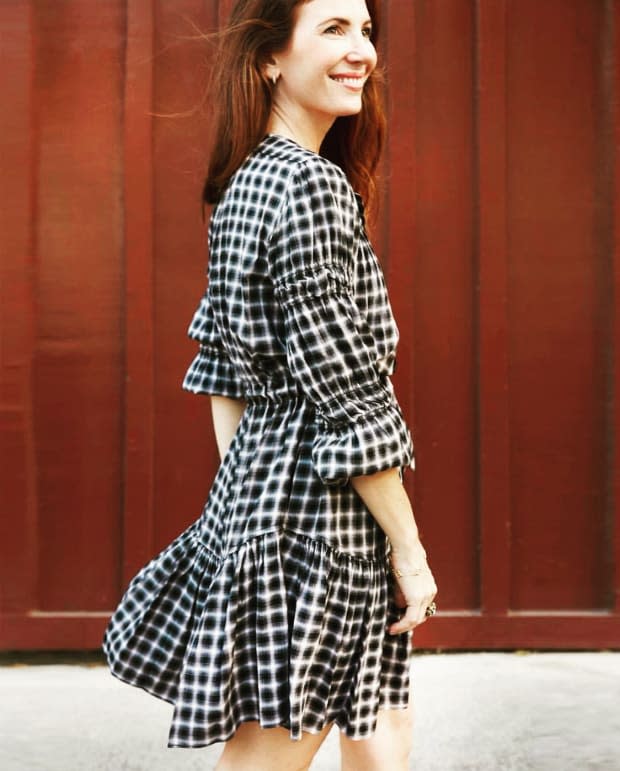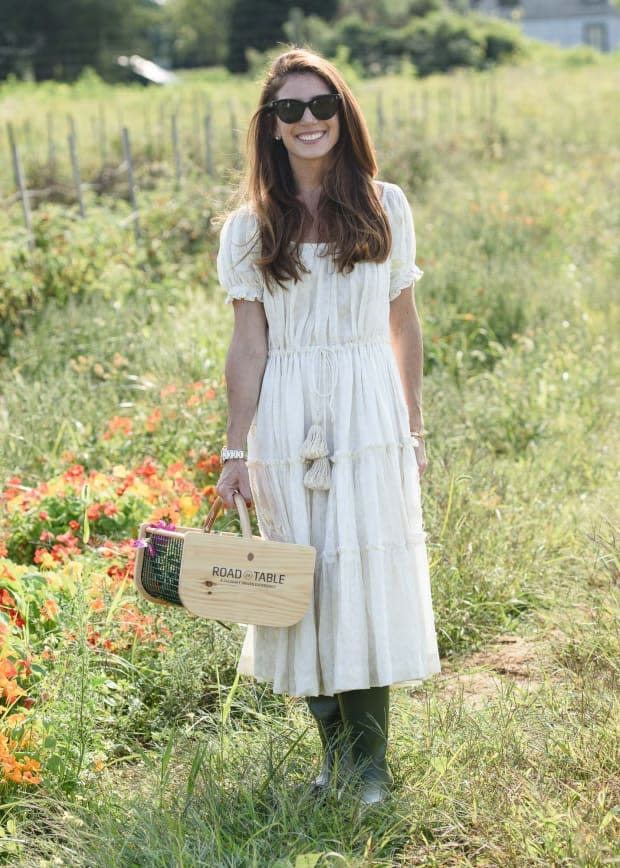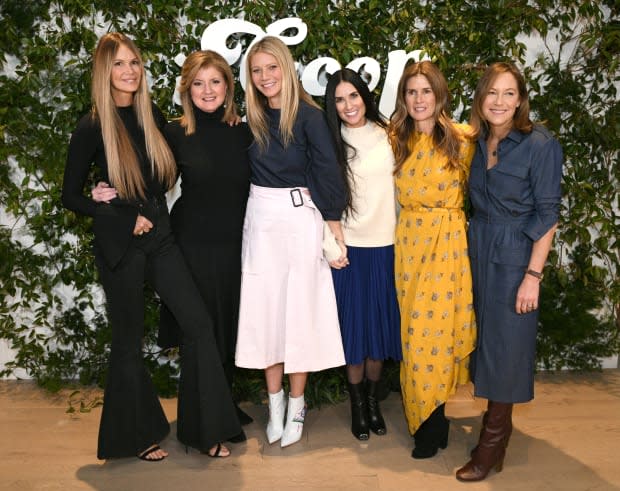How Kimberly Kreuzberger Went From Selling Ads at Condé Nast to Doubling Media Revenue at Goop
"You're never prepared for that," says the Chief Revenue Officer, about meeting Founder & CEO Gwyneth Paltrow for the first time.

In our long-running series "How I'm Making It," we talk to people making a living in the fashion and beauty industries about how they broke in and found success.
Behind the holiday gift guides that put Neiman Marcus's to shame, the infamous $15K gold dildo, and Founder & CEO Gwyneth Paltrow spilling the health and wellness tea with her A-list friends at the famed In Goop Health summits, there's an all-female executive team at Goop HQ making sure the multi-platform wellness and lifestyle brand continues breaking ground — and staying profitable — in an ever-evolving media and retail landscape.
That includes Goop's Chief Revenue Officer Kimberly Kreuzberger, who does exactly that by generating advertising sales and developing brand partnerships in innovative, experiential and very Goop kinds of ways. She joined the company in 2015 after spending 13 years growing her career in traditional publishing at Condé Nast titles Vogue and Lucky (RIP) and at Time, Inc. as the Advertising Director at InStyle, where she oversaw ad revenue for print and digital.
Making the jump to a "pure-play digital" title, as Kreuzberger will explain below, was a huge leap — not to mention a literal cross-country move from Brooklyn to Brentwood with her husband and two small children — into a new and wide-open playing field.
Kreuzberger joined Goop as VP of Brand Partnerships and Sales — a newly created role at the time — as the company was on the brink of expansion. A year after she joined, Goop entered the beauty e-commerce space by launching fragrance and Goop by Juice Beauty, and debuted the in-house fashion line G. Label as well as the first print magazine. The same year, the company also introduced its frenzy-inducing, four-figure ticket price "In Goop Health Summit," known for inventive wellness activations, like flavored oxygen bars and aerial yoga, plus Paltrow-adjacent panelists and attendees.
Kreuzberger was promoted to her current role after three years and now leads over 40 staffers covering sales, marketing, events and advertising. She and her team are constantly looking for new revenue streams from collaborations, to live events, to experiential retail. Her approach has helped Goop secure $75 million in three rounds of funding and the proof of success is in the numbers. Under Kreuzberger's watch, Goop doubled revenue in 2018 and boasts a 90% retention rate for luxury clients.
Before the most recent In Goop Health in New York, Kreuzberger jumped on the phone with Fashionista to share how her traditional publishing background took her to one of the most untraditional — and headline-making — companies in business, why Goop ended up being a new home for so many former Lucky staffers and — we know you're all dying to know — what it's like to interview with Paltrow.

How did you get started in the publishing industry?
I started at American Cheerleader magazine as a coordinator. I was a college cheerleader and I always loved the magazine. My team was a national champion in college, so I used to be featured. I wrote them when I was in school and I ended up getting the job and I sent roses to the president of the company. Looking back, that was crazy.
They owned a bunch of niche magazines, like Pointe Magazine and Dance Spirit, but turns out nobody who worked there was in cheerleading or dancing. They were [mostly] Condé Nast or Hearst former assistants who were told to come to this niche publishing house to get sales or senior editor experience and then go back for a bigger job.
I ended up meeting all these people who, every three or six months would get jobs at Fairchild, Condé, Hearst or Time, Inc. After two years, one former colleague set me up on an interview at Footwear News. So I went into a trade at a big publishing house and worked at FN for two years, then went on to Jane and Lucky. After Lucky, I went to Vogue for a little bit and then InStyle for five and a half years.
Why did you pursue the sales rather than editorial path in publishing?
I was living in New York City in the early 2000s, so it was a little bit of survival with financials. Because American Cheerleader was really small, I was able to learn both sides of the business [and knew there] was definitely a pretty significant difference in the publishing side versus the editorial side for the point of entry in terms of what they were making. I came from a really humble upbringing, so I wasn't subsidized. I really needed to make money to stay in New York, which I was loving in my 20s. So that made the decision for me.
You came up during the heavy shift to digital. So how did you learn to change and pivot sales strategies regularly? What was that learning curve like?
That's what made it relevant and exciting for me. I was at Lucky when they let non-college students join Facebook. We were in the heyday of Lucky. I remember a bunch of us setting up profiles and thinking, 'This is insane. It's going to change the community aspect of how people connect.'
Then, at the same time, I was balancing having children and what seemed life-stage-wise appropriate. Should I be jumping? Should I go to Facebook? I was astutely aware that I was missing the boat — I really need to go — but I also needed to be my best self.
Six months leading up to my youngest child turning one, I was actively looking for a role at a pure-play digital and that's how I landed at Goop.
What about Goop fit into your career and stage-of-life needs?
To be completely honest, going to Goop for me was a little bit of a lean out. I had two newborns basically when I started the interview process. I ended up joining almost almost nine months after my first meeting with them.
At the time, Goop was a really small business. The woman who was the CRO before me had a really strong background after a year at Refinery29. She was very digital-focused, so I thought I could learn a lot from her in a smaller business and get my feet wet. Then, Goop became a rocket ship. All of a sudden we were hiring two employees a month. The media business was growing rapidly. Our CRO ended up becoming the president of Girlboss and I moved into a high-level management role. The revenue started doubling year over year. We had a lot of momentum. It became a much bigger job that I ever had in publishing.
I have to ask: What is it like interviewing with Gwyneth Paltrow?
I knew a little bit about her from the content. You're never prepared for that, but she's so human and she's such a mother first.
I met with her at her house. Her kids are running around. If Apple or Moses are calling, she's like, 'I'm so sorry, I have to take this call.' To me, that was so refreshing. I grew in an environment in publishing where you really shielded that part of your life and compartmentalized being a mother at work and being an employee. So the first time I saw the blend and felt really confident that I didn't have to hide who I was, first and foremost, which is the mother of two small children and in the interview, I told her that. I was nervous and I also had a lot to learn.
In this role, it's like, all you're doing is watching customer behaviors and targeting how to more efficiently provide value to the customer through the media platform. So that was all a huge transition and Gwyneth was really like, 'I'm learning, too. I've never run any e-commerce events. There's so much for all of us to learn together, but we're going to hire the right people. We're going to build the right infrastructure and we're going to support each other and work really collaboratively.' Still to this day it's exactly her mantra.
What do you think she really values in an interview candidate?
I can't speak for her at all, but I think she's really about honesty and humility. It's OK to say, 'I worked here and didn't work for me' or 'I was unprepared for that job and I want to take a step back and take this role.' The more she can learn about you as a person, as an individual, the more she can see where you fit in with this company and what value you can bring to the business as a person, outside of work performance.
We're building a company of people who might be like-minded in certain beliefs, but she doesn't want clones of each other. Every week, we do a weekly standup and she takes 30 minutes to lead this meeting with entire company. In that meeting, she's talking about things we might have not gotten right and things we're doing really well. It's all about culture. What could we be doing to support each other? Everyone submits questions, like, 'What's going on with the beauty business?' 'When's our next pop-up going to be?' She answers them to give you a bit of insight of where we're going, how nine months [out] looks and not just right now. Culture, first and foremost, is what she's spending a lot of her energy on. There's tons of diversity and people of different backgrounds.
Your job is to find new revenue sources, which is kind of a wide-open playing field at this point in media. What is your approach and process?
For us, we are creating a model. We are very much a unicorn. I don't really have anything that I look towards, like 'We want to be Amazon. I just want to copy that,' or, 'I want to watch what they're doing,' or, 'What's Refinery or Girlboss doing?' Running that group is very much like keeping your eye on the prize. I'm very laser-focused on getting it right for what we're trying to build.
Most importantly, [I make sure that what] I'm doing at Goop is effective and, to me, that is that we are servicing the customer. We're bringing value to her and we're also integrating partners that stand for what we believe in from an editorial perspective that don't compromise anything that we're doing at Goop. So we're looking for partners who add value and that's really different from publishing, which was years of going after advertisers as a land grab, whether it's Walmart or Macy's or L'Oreal.
Tell me more about that process.
So we're really talking to beauty brands that are clean or meet our clean standards, which, some of the biggest advertisers out there are technically not clean. I have to be really knowledgeable about what we're trying to do as a business and educating [my team so] they're not just hustling, just trying to close deals with brands that don't make sense for Goop. [We run it by] Gwyneth and say, 'What do you think?' Or, we meet with the editors and ask, 'Would we ever genuinely cover this brand?' It's really a luxury in this day and age that we can be so specific and vertical. We can be so thoughtful in our approach, but it's because we built a business that has multiple revenue streams and ultimately we're building an e-commerce business with partners that support that.
We [also create] really interesting channels and have an omni-channel approach. So when we're working with a brand that I'm looking to integrate, maybe we're distributing their water at a pop-up or permanent retail stores and they help at a summit with 100-plus women. Maybe they're on the podcast and in a story on hydration and the importance of it. [We include the brand] without being so literal. It's about tapping into to all of these channels and trickling the brand into each of them. So we're never going super deep where the story is sponsorships and giant logos.

For you, what goes into planning an In Goop Health Summit?
I create product, whether that's experiential, content-driven with our editors, or retail-focused. So I'm constantly trying to make ad products or services that create experience to have something else to deliver to our customers. When you're walking around, you're able to test and dabble some of these modern wellness experiences. It can be a cryofacial, a B-12 shot, aerial yoga or any of the exciting activations we have on site.
The other purpose is content-focused. We have panels that our consumers can pop into throughout the day and basically our edit comes to life in it. Gwyneth held a panel with some of her friends and women she admires and it gives that Gwyneth-slash-Goop-slash-celeb halo that our consumers also like. It keeps it really special and it's our point of difference when other wellness brands are out there doing similar conference or summits. We try to intertwine a little bit of that Gwyneth touch.
There are multiple Lucky vets at Goop, including Chief Content Officer Elise Loehnen, Beauty Director Jean Godfrey June and Senior Beauty Editor Megan O'Neill. What about the Lucky experience translates so well to Goop?
At one point there were six or seven of us that had come and gone through the doors. I think we hire top talent and I think Lucky, when we all worked there in the heyday, it was best in class. It was really progressive; nobody was doing what we were doing. I was there '06 to '09; we created Lucky Shops, this really experiential product, that stems from the actual DNA of the content. We're basically trying to do the same thing here. What I love most about Goop, I work with the smartest women I've ever crossed paths with. I think people want to work here, so we're able to acquire incredible talent. [Former Lucky Beauty Director] Jean Godfrey June is a legend.
So what advice do you have for young people starting their careers in media and are anxious about how to grow their careers in this volatile industry?
Attach yourself first and foremost to somebody you think is successful, even not in the same career field; really understand their path and what advice they'd give you. I always had mentors that would always point me in the right direction and they were always 10 years older.
Social media is a mini version of your resumé. If you want to do something creative or artistic, you have this chance to display this view of yourself, how you think, how you write and how you brand [yourself] in a way that I never had. All these platforms allow you to create a snapshot who you want to be even if you don't have a big following. Something I value — and probably not everybody values — we need workhorses, not show horses. So sometimes I'm more impressed with people with less followers who find a way to show me a creative glimpse into their world because, more than anything, we need resourceful problem solvers.
I also really appreciate people who have side-hustles. Back in the day, you were so scared to tell your boss you were working on a website or something on the side. One of my top performers for us on the partnerships team has 100K followers and she's shooting content on her tripod before work in the West Village. These young women that I want to recruit have this type A, go-getter energy. They're not just putting it into their work, they're trying to build things. I could be your best advocate for helping to do that. Or Goop could be your best advocate, so don't hide behind the curtain of an only one-dimensional version of yourself.
This interview has been edited and condensed for clarity.
Homepage photo: Courtesy of Goop
Want the latest fashion industry news first? Sign up for our daily newsletter.
